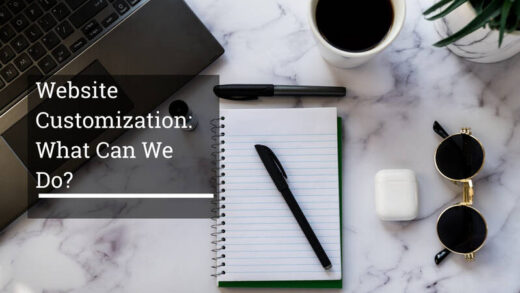
No matter how brilliant your website design is, if your site content is hard to come by, then your site is as useful as an empty shell.
Here are some tips to improve the usability of your website and ensure that it performs its functions optimally.
The first method is to make sure that the typography of your content is appropriate. If you have large blocks of text, be sure to use CSS to space the lines accordingly.
The longer a single line of text is, the greater the height of each line should be. Also, make sure that the font size of your text is large enough to read easily.
Some sites have text 10 pixels tall in Verdana font; While that may look neat and clean, you have to strain your eyes to read the actual text.
Make it easy for visitors to find the content they want on your site.
If you have thousands of articles on your site and a particular visitor wants to find a single article from that pile, you must provide a workable means of allowing visitors to do so without problems.
Whether it’s a SQL-based database search engine or just a glossary or article index that you have, providing this feature will ensure that your visitors can use your site with ease.
Make sure your site loads fast if you don’t want to lose visitors. Most internet users will abandon a website if it doesn’t fully load within 15 seconds, so make sure your website is delivered to visitors as soon as possible to retain their attention.
Lastly, test each and every link on your site before they connect. There is nothing more effective in tarnishing your professional image than broken links, so be very careful with that.
The Importance of a Sitemap
A sitemap is often considered redundant in the process of building a website, and that is the fact if you made a sitemap for the sake of having one.
By highlighting the importance of having a well-constructed sitemap, you will be able to tailor your own sitemap to your own needs.
1) Navigation purposes
A sitemap literally acts like a map of your site. If your visitors browse your site and get lost among the thousands of pages on your site, they can always check your sitemap to see where they are and navigate your pages with the greatest of ease.
2) Convey the theme of your site
When your visitors upload your sitemap, they will get the gist of your site in no time. There is no need to get a “whole picture” of your site by reading every page, and by doing so, you are saving your visitors time.
3) Site optimization purposes
When you create a sitemap, you are actually creating a single page that contains links to each of the pages on your site.
Imagine what happens when search engine robots land on this page – they will follow the links on the sitemap, and naturally every page on your site will be indexed by search engines.
It is also for this purpose that a link to the sitemap should be prominently placed on the main page of your website.
4) Organization and relevance
A sitemap allows you to have a complete panoramic view of the structure of your site, and whenever you need to add new content or new sections, you can take into account the existing hierarchy just by looking at the sitemap.
As a result, you will have a perfectly organized site with everything sorted according to relevance.
For the above reasons, it is more important to implement a sitemap for large website projects. In this way, you will be able to keep your website easily accessible and perfectly organized for everyone.
Make It Easy To Buy From Your Site
Convincing your prospects to buy from you is hard work, but have you ever thought that you are making the process twice as difficult for both parties if your prospects are convinced but don’t know how to buy from you?
No matter how good you are at convincing your prospects, they won’t buy if they find the process cumbersome.
First, you’ll want to verify that people can find your order form easily and seamlessly. You can write a clear and concise paragraph to direct your prospects to your order form so that you can minimize the chances of them getting lost.
You can also reduce the chances of losing prospects by prominently linking to their order page from any other page on your site.
Also, do you offer multiple payment options? Some people may feel comfortable paying via Paypal, some may only want to pay with their credit card, and others may want to send a check.
The more options you offer, the better your chances of meeting the payment method desired by your prospects. After all, it wouldn’t make any sense to sell to a potential customer only to find that they won’t be able to pay you when you want.
On the other hand, you will want to show that you are a credible trader. Is your order form protected by encryption technology?
I would like to search SSL for this. You can also offer a money-back guarantee so people feel safe buying from you. How about after-sales support? Who do they contact when they have problems after purchase?
Alternatively, you can add customer testimonials, your contact information, address, etc. to increase the confidence of your potential customers. Make them feel safe buying something from you, a total stranger to them at the other end of the internet.
As a conclusion, it would be very unfortunate if you sold a lot and well to a potential customer and something went wrong when he or she is willing to pay. Eliminate any chance of that to maximize your profit!
Mistakes To Avoid When Using Web Templates
Website templates are very affordable and save you a lot of effort and time when you want to create a new design for your website.
However, many people make mistakes in the process of choosing and using a web template and end up with something that does not look like the image they had in mind. Here are some guidelines to help you avoid these mistakes.
The first obvious mistake to be aware of is using a template that is very popular. If many people use the same template, your website will not appear unique at all and your credibility as a strong and different website will be tarnished.
In other words, it will appear generic just like your next door neighbors.
The goal of using a web template is to save time and effort. Just change the appropriate title and details and you’re done. The biggest mistake made is customizing the template beyond recognition.
While that may be good in the sense that you are creating a unique graphic, you are challenging the very purpose of using a web template – saving time and effort.
However, on the opposite side, if a template you buy is suitable but some changes need to be made to suit your site’s theme, then you will have to take some time to make the changes.
For example, you may find a really nice template that suits your hobby site, except the original designer has put a stamp image in the header.
You can find images of garden plants and shovels to replace stamps for your gardening hobby site. However, only make the necessary changes and do not redesign the entire template.
In some circumstances, some people just choose the wrong templates. This is a very subjective topic, but you need to be careful when selecting templates that suit your audience.
Don’t choose templates just because they are pretty, choose them because they serve your purpose.
Reducing Load Time Through Image Optimization
Despite the fact that every year more Internet users switch to broadband, a large part of the web population still operates with good dial-up connections.
Therefore, it is not wise to remove them from the equation when designing your website, and a very important consideration for dial-up users to keep in mind is your website load time.
Generally, all the text on your website will load in no time, even on a dial-up connection. The culprit for slow loading sites is mostly large images on your website, and it is very important to strike a delicate balance between using enough images to attract your users and not clogging up your site’s overall loading time.
You should also try harder and optimize every image on your site to make sure it loads in the shortest time possible.
What I really mean is to use image editing software to remove unnecessary information in your images and thus effectively reduce the file size of your image without affecting its appearance.
If you have Photoshop, it will be obvious that when you save an image as a JPEG file, a dialog box appears allowing you to choose the “quality” of the JPEG image; normally a setting of 8 to 10 is sufficient. as it will preserve the quality of your image while saving it in a small file size.
If you don’t have Photoshop, there are many free image compressors online that you can download and use to reduce the file size of your image.
On the other hand, you can choose to save your images in PNG format for the best quality with the smallest file size.
You can also save your images in GIF format – image editing software cuts out all unused color information in your image, giving you the smallest file size possible.
However, saving in GIF format will often compromise the appearance of your image, so make your choice wisely!




1 Response
[…] No matter how brilliant your website design is, if your site content is hard to come by, then your site is as useful as an empty shell. […]